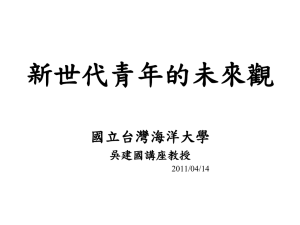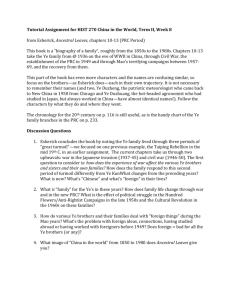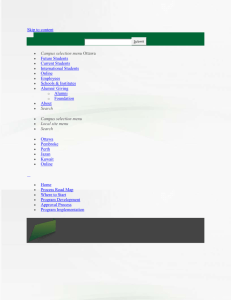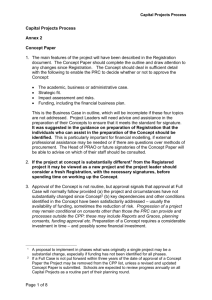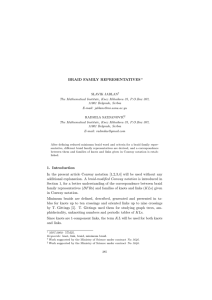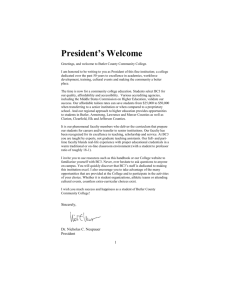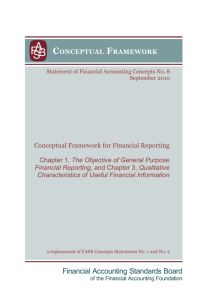Clean Air Asia Strategy
advertisement
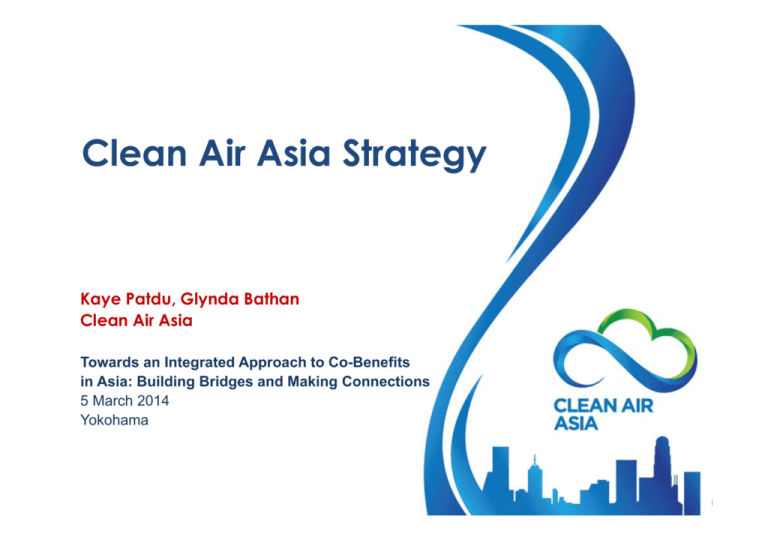
Clean Air Asia Strategy Kaye Patdu, Glynda Bathan Clean Air Asia Towards an Integrated Approach to Co-Benefits in Asia: Building Bridges and Making Connections 5 March 2014 Yokohama About Clean Air Asia 2 Mission: to promote better air quality and livable cities by translating knowledge to policies and actions that reduce air pollution and greenhouse gas emissions from transport, energy and other sectors. Clean Air Asia was established by the Asian Development Bank, World Bank and USAID in 2001. Since 2007, Clean Air Asia consists of • the Clean Air Asia Center as an independent NGO • a UN recognized partnership of more than 240 organizations in Asia and worldwide • Country Networks in China, India, Indonesia, Nepal, Pakistan, Philippines, Sri Lanka and Vietnam . Our Organization Board of Trustees Clean Air Asia Center • • • • • Executive Director Deputy Executive Director Finance and Admin Manager BAQ Coordinator Managers and Staff Country Networks • • • • • • • • China India Indonesia Nepal Pakistan Philippines Sri Lanka Vietnam Clean Air Asia Partnership Council Clean Air Asia Partnership • • • • • • Cities Government NGOs Academic and research institutes Private sector Development agencies and foundations 4 Our Strategy What we aim for Outcomes Clean Air Asia as a trusted CHANGE MAKER Reduced air pollution and greenhouse gas emissions Improved health Energy savings Livable cities • Decision makers use reliable analysis, knowledge, data and effective tools to understand the problems and identify solutions • Stakeholders at the city, national and regional level cooperate better through networks & partnerships • Policies and programs are in place that are science‐based, stakeholder inclusive, and effective Clean Air Asia Programs Air Quality and Climate Change Low Emissions Urban Development Clean Fuels and Vehicles Green Freight and Logistics Input from Clean Air Asia Partnership and other partners Milestones until 2013 1 Establishing a regional air quality network in Asia 2 Monitoring air quality trends to shape policies 3 Linking government and cities in China 4 Helping cities reduce air pollution and greenhouse gas emissions 5 Putting sustainable transport on the agenda in Asia 6 Quantifying emission reduction potential for low emission cities 7 Evaluating emissions impact of transport projects and policies 8 Championing the right to walk 9 Developing a road map for clean fuels and vehicles in Asia 10 Initiating green freight programs and partnerships in Asia Air Quality and Climate Change Program Clean Air Asia’s role 1. Guidance Framework for Better Air Quality in Asian Cities 2. Regional system for knowledge management and capacity building on air quality and GHG management (includes BAQ conferences) 3. Support cities on air pollution and GHG management 1. Guidance Framework for Better Air Quality in Asian Cities Governmental Meetings on Urban Air Quality in Asia ● Objective: harmonize approaches between Asian countries in tackling urban air pollution and related areas ● Environment ministries ● Organized by UNEP and Clean Air Asia ● Supported by Sida/Sweden, GAPF, CCAC 1st: Yogyakarta Dec 2006 Agree on objectives Govt Meetings 2nd Bangkok Dec 2008 Long Term Vision on Urban Air Quality 3rd: Singapore Nov 2010 AQM Priorities 4th: Bangkok Feb 2013 Guidance Framework table of contents 5th: Colombo Oct 2014 Guidance Framework draft 2. Better Air Quality (BAQ) Conference ● Leading event on air quality in Asia, covering air quality, climate change, transport, energy, and industry ● It has grown into a community of practitioners , policy makers and businesses who meet every two years for networking, learning and sharing experiences ● BAQ has proven to influence policies, initiate new projects and establish partnerships ● Organized by Clean Air Asia in partnership with the host city, national environment ministry, ADB and World Bank, and several supporting organizations www.baqconference.org 3. Support cities on air pollution and GHG management Asia Cities that Clean Air Asia currently works with East Asia 1. Beijing, PRC 2. Shanghai, PRC 3. Guangzhou, PRC 4. Hanghzou, PRC 5. Jinan, PRC PEER Cities 6. Urumqi, PRC 7. Changchun, PRC 8. Harbin, PRC 9. Chongqing, PRC 10. Ulaanbaatar, MON Southeast Asia 1. Bangkok, THA 2. Chiang Mai, THA 3. Korat, THA 4. Metro Manila, PHL 5. Cebu, PHL 6. Hanoi, VIE 7. HCMC, VIE 8. Jakarta, INC 9. Iskandar, MAL 10. Yangon, MYA South Asia 1. Colombo, SRI 2. Kathmandu, NEP 3. Dhaka, BAN 4. Delhi, IND 1. Asia: Hong Kong, Singapore, Tokyo, Seoul 2. City in Europe, US, Australia, Latin America Clean Air Asia Partnership: experts and organizations provide support to countries and cities Target Cities 6. Bangalore, IND 7. Pune, IND 8. Ahmedabad, IND + Cities in Clean Air Asia Partnership Asian cities with a population of at least 1 million 180+ cities 3. Supporting Chinese Cities in AQM since 2002 ● China City Air Quality Management Network in collaboration with FECO‐MEP (2005‐2013) ● Facilitating bottom‐up regional AQM collaboration platforms in Yangtze River Delta (YRD) and Pearl River Delta (PRD) ● Training and application of AQM tools ‐ Clean Air Scorecard and Clean Air Report ● China participation at BAQ Conferences ● Initiation and promotion of green freight development 10 Towards an Integrated Approach to Co-Benefits in Asia ● Institutional ● Gap: AP & CC mandate within different Ministries; mandate for integration at local development agencies (to create linkage with economic development, etc)? ● Opportunity: AP & CC goals integrated into urban/local development goal/plans ● Communication ● Gap: While there is existing information that an integrated approach has multiple benefits, this needs to be communicated better (esp on cost‐benefits) ● Opportunity: Strengthen efforts to communicate co‐benefits to trigger policy action; document case studies/best practices on co‐benefits; ● Resources ● Gap: limited resources available to address climate (depending on local priorities) ● Opportunity: Importance of engaging different stakeholders (government, scientific community, private sector, civil society, etc) Better Air Quality 19-21 November 2014 SAVE THE DATES 19 to 21 November 2014 Bandaranaike Memorial International Conference Hall, Colombo, Sri Lanka BAQ 2014 Email: baq@cleanairasia.org Website: www.baq2014.org 8th Regional EST Forum in Asia Email: est@uncrd.or.jp Website: www.uncrd.or.jp For more information: www.cleanairasia.org For more information: www.cleanairasia.org Clean Air Asia Center center@cleanairasia.org Unit 3505 Robinsons Equitable Tower ADB Avenue, Pasig City Metro Manila 1605 Philippines Clean Air Asia China Office Clean Air Asia India Office china@cleanairasia.org 901A Reignwood Building, No. 8 YongAnDongLi Jianguomenwai Avenue Beijing China india@cleanairasia.org 1st Floor, Building No. 4 Thyagraj Nagar Market, Lodhi Colony New Delhi 110003 India . . Clean Air Asia Country Networks . . . . . China India Indonesia Nepal Pakistan Philippines Sri Lanka Vietnam Clean Air Asia Center Members • Asia Clean Fuels Association • Corning • Shell 240 Clean Air Asia Partnership Members • Cities • Environment ministries and government agencies • Development agencies and foundations • Non‐government organizations • Academic and research institutions • Private sector companies and associations Donors in 2012 to 2013 Asian Development Bank Cities Development Initiative for Asia ClimateWorks Foundation DHL/IKEA/UPS Energy Foundation Fredskorpset Norway Fu Tak Iam Foundation German International Cooperation (GIZ) Institute for Global Environmental Strategies (IGES) Institute for Transport Policy Studies Institute for Transportation and Development Policy International Union for Conservation of Nature L'Agence Française de Développement (AFD) MAHA Pilipinas Shell Rockefeller Brothers Fund Shakti Foundation Shell Foundation United Nations Environment Program Partnership for Clean Fuels and Vehicles (UNEP PCFV) USAID CEnergy Veolia World Bank 13



